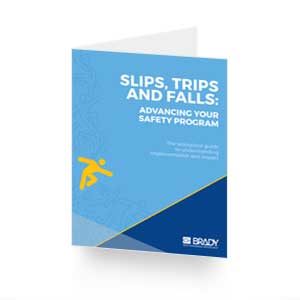Labels for Safety, Visuals and Facility ID Desktop Printers
Labels for Product, Wire and Lab ID Benchtop Printers
Labels for Safety, Visuals and Facility ID Desktop Printers
Labels for Product, Wire and Lab ID Benchtop Printers
Safety and Facility ID Desktop Printers
Product, Wire and Lab ID Benchtop Printers
Barcode Scanner and Printer Kits
Barcode Scanner and Printer Kits
PaintStripe Floor Marking Stencils
Valve Lockouts & Hose Lockouts
Group Lock Boxes & Permit Control
Brady Safety Lockout Tagout Services
Pipe Marker Accessories & Mounting Brackets
Maintenance and Production Tags
Calculators and Assessment Tools
Product Finders and Data Sheets
Ensure your facility has the right practices, training and response plans in place.
Slips, trips, and falls occur when there is too little friction or traction on a walking surface, when a foot or lower leg hits an object while the rest of the body continues to move, or when the center of balance is lost resulting in a descent to the floor, against an object or to a surface at a lower level than the original surface.1 These incidents are often caused by slippery, irregular or uneven surfaces, obstacles on the floor or uncovered/unidentified hazard areas.
Hazards relating to slips, trips and falls are frequently top offenders on OSHA's top 10 violation lists. In 2018 alone, slips, trips, and falls were tied to three of the top ten violations, and two of the top three. These violations included hazards relating to fall protection (#1), scaffolding (#3), and ladders (#6).2
This free guide provides tools and resources that will help you learn about slips, trips and falls prevention in your workplace. Get it today!
Take a look at some visual workplace examples in this FREE guide:
Download Now
This standard supports the safety of exit routes. Some of the key elements that apply to slips, trips and fall in this standard include:
This standard supports worker safety by keeping workplaces clean and safe from hazards, including:
You wouldn't be here if you didn't think slips, trips, and falls prevention was important. You also should know by now the implications of not taking the right steps to complying with OSHA's Walking-Working Surfaces standard and the potential dangers associated to non-compliance. Now, let's outline each step that you can take to prevent slips, trips and falls hazards.

For an in depth look at each of these steps, download our "Slips Trips and Falls Guide"
Despite our best efforts, accidents sometimes happen. In the event that a slip, trip or fall does occur at your workplace, you need a plan that allows everyone to act quickly and effectively. When you're creating a response plan here are a few guidelines to keep in mind:
This may sound like a given, but many times in the heat of the moment, those who immediately respond to an emergency may not know what to do. Make sure there is a clear and easy way to provide first aid or call for emergency medical assistance.
This is when you can identify area of training, different products or signage needs, and housekeeping practices that should be used to ensure employee safety and compliance to OSHA standards in the future.
Sources:

This free guide provides tools and resources that will help you learn about slips, trips and falls prevention in your workplace.
Download Now
Review your current safety program and ensure you have the right plans in place. This infographic offers some quick tips to get started.
Download Now
For information on how and where slips, trips and falls can occur in your workplace, check out this handy infographic.
Download Now